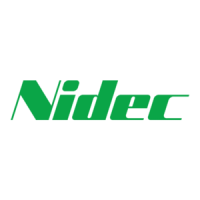What causes bus under voltage during running of Nidec DC Drives?
- CChristian MillerSep 4, 2025
A bus under voltage during the operation of Nidec DC Drives is caused by power grid low voltage, so check the input power source.

What causes bus under voltage during running of Nidec DC Drives?
A bus under voltage during the operation of Nidec DC Drives is caused by power grid low voltage, so check the input power source.
What to do if Nidec NE300-4T0450G/0550P DC Drives show ground fault?
If your Nidec DC Drives are indicating a ground fault, it could be due to a short circuit in one of the output phases. Check whether the electric motor insulation is weakening. Also, check whether the wiring between the frequency converter and the electric motor is damaged.
What to do if Nidec NE300-4T0450G/0550P DC Drives show load short-circuit?
If your Nidec DC Drives are displaying a load short-circuit error, check whether the electric motor coil is short circuit. If the inverting module IGBT is damaged, ask for the services from manufacturers.
What to do if Nidec DC Drives show output phase loss?
If your Nidec DC Drives are showing an output phase loss, check the U-V-W motor wiring. Also, if there is a serious unbalance in output, check the load.
What to do if Nidec DC Drives show input phase loss?
If your Nidec DC Drives are indicating an input phase loss, it means the input RST has phase loss or imbalance, so check input voltage.
Details about drive model number components and their meaning.
Information on NE200 and NE300 product series, including specifications.
Technical specifications for NE200 and NE300 drives across different control modes.
Physical dimensions and outline drawings of NE200 and NE300 drives.
Important precautions and considerations for wiring the main circuit, including power supply and motor connections.
Explanation of the drive's menu structure and procedures for viewing and modifying function codes.
Parameters related to start and stop control, including start modes, DC brake, and acceleration/deceleration.
Parameters specific to vector control, including speed and current loop adjustments.
Parameters for V/F control, covering V/F curve settings and torque boost.
Parameters for configuring motor characteristics like type, power, current, and inductance.
Parameters for PID control setup, including channel selection, gain, and timing.
Parameters for multi-step speed control and PLC operation, including frequency and timing settings.
Protection parameters covering overload, overvoltage, phase loss, and communication faults.
Parameters for communication settings, including Modbus and CAN protocols.
Adjusts the carrier frequency, affecting motor noise, temperature, and drive temperature.
Details on detected faults, possible causes, and corresponding solutions for NE200/300 series drives.
Information on warning codes, their descriptions, and behavior while the drive is running.
General troubleshooting guidance for common abnormal situations encountered during drive usage.
Guidelines for routine maintenance checks, including operating environment and drive/motor inspections.
Recommended periodic inspection schedule and criteria for drive and motor components.
Lists fault codes related to the encoder and their troubleshooting steps.
Describes the format of Modbus RTU protocol, including frame structure and addresses.
Explains Modbus function codes for reading and writing parameters and provides examples.
Details the relationship between function codes and Modbus register addresses.










